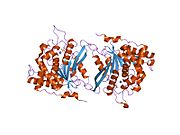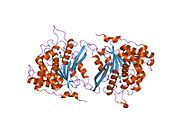From Wikipedia, the free encyclopedia
Protein-coding gene in the species Homo sapiens
QPCT Available structures PDB Ortholog search: PDBe RCSB List of PDB id codes 2ZEE , 2ZEF , 2AFU , 2AFM , 2AFX , 4YU9 , 2ZEL , 2ZEG , 2ZEM , 4YWY , 2AFZ , 3PBB , 2ZEH , 2AFS , 3SI0 , 2ZEP , 3PBE , 2ZEO , 2ZED , 2AFO , 2ZEN , 2AFW
Identifiers Aliases QPCT External IDs OMIM : 607065 MGI : 1917786 HomoloGene : 8238 GeneCards : QPCT Wikidata
Glutaminyl-peptide cyclotransferase is an enzyme that in humans is encoded by the QPCT gene .[5] [6]
This gene encodes human pituitary glutaminyl cyclase , which is responsible for the presence of pyroglutamyl residues in many neuroendocrine peptides . The amino acid sequence of this enzyme is 86% identical to that of bovine glutaminyl cyclase.[6]
References [ edit ] Further reading [ edit ]
Busby WH, Quackenbush GE, Humm J, et al. (1987). "An enzyme(s) that converts glutaminyl-peptides into pyroglutamyl-peptides. Presence in pituitary, brain, adrenal medulla, and lymphocytes" . J. Biol. Chem . 262 (18): 8532–6. doi :10.1016/S0021-9258(18)47446-7 PMID 3597387 . Bateman RC, Temple JS, Misquitta SA, Booth RE (2001). "Evidence for essential histidines in human pituitary glutaminyl cyclase". Biochemistry . 40 (37): 11246–50. doi :10.1021/bi011177o . PMID 11551224 . Schilling S, Hoffmann T, Rosche F, et al. (2002). "Heterologous expression and characterization of human glutaminyl cyclase: evidence for a disulfide bond with importance for catalytic activity". Biochemistry . 41 (35): 10849–57. doi :10.1021/bi0260381 . PMID 12196024 . Strausberg RL, Feingold EA, Grouse LH, et al. (2003). "Generation and initial analysis of more than 15,000 full-length human and mouse cDNA sequences" . Proc. Natl. Acad. Sci. U.S.A . 99 (26): 16899–903. Bibcode :2002PNAS...9916899M . doi :10.1073/pnas.242603899 PMC 139241 PMID 12477932 . Schilling S, Niestroj AJ, Rahfeld JU, et al. (2004). "Identification of human glutaminyl cyclase as a metalloenzyme. Potent inhibition by imidazole derivatives and heterocyclic chelators" . J. Biol. Chem . 278 (50): 49773–9. doi :10.1074/jbc.M309077200 PMID 14522962 . Booth RE, Misquitta SA, Bateman RC (2004). "Human pituitary glutaminyl cyclase: expression in insect cells and dye affinity purification". Protein Expr. Purif . 32 (1): 141–6. doi :10.1016/S1046-5928(03)00226-2 . PMID 14680951 . Ezura Y, Kajita M, Ishida R, et al. (2005). "Association of multiple nucleotide variations in the pituitary glutaminyl cyclase gene (QPCT) with low radial BMD in adult women" . J. Bone Miner. Res . 19 (8): 1296–301. doi :10.1359/JBMR.040324 PMID 15231017 . S2CID 8470506 . Gerhard DS, Wagner L, Feingold EA, et al. (2004). "The Status, Quality, and Expansion of the NIH Full-Length cDNA Project: The Mammalian Gene Collection (MGC)" . Genome Res . 14 (10B): 2121–7. doi :10.1101/gr.2596504 . PMC 528928 PMID 15489334 . Huang KF, Liu YL, Cheng WJ, et al. (2005). "Crystal structures of human glutaminyl cyclase, an enzyme responsible for protein N-terminal pyroglutamate formation" . Proc. Natl. Acad. Sci. U.S.A . 102 (37): 13117–22. Bibcode :2005PNAS..10213117H . doi :10.1073/pnas.0504184102 PMC 1201592 PMID 16135565 . Huang QY, Kung AW (2007). "The association of common polymorphisms in the QPCT gene with bone mineral density in the Chinese population" . Journal of Human Genetics . 52 (9): 757–62. doi :10.1007/s10038-007-0178-6 PMID 17687619 .
PDB gallery
2afm : Crystal structure of human glutaminyl cyclase at pH 6.5
2afo : Crystal structure of human glutaminyl cyclase at pH 8.0
2afs : Crystal structure of the genetic mutant R54W of human glutaminyl cyclase
2afu : Crystal structure of human glutaminyl cyclase in complex with glutamine t-butyl ester
2afw : Crystal structure of human glutaminyl cyclase in complex with N-acetylhistamine
2afx : Crystal structure of human glutaminyl cyclase in complex with 1-benzylimidazole
2afz : Crystal structure of human glutaminyl cyclase in complex with 1-vinylimidazole













